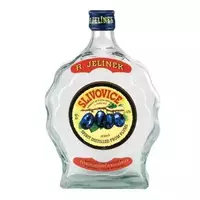Slivovica

Slivovitsa is an alcoholic drink that is produced from fermented plum juice and the strength of which is 45 vol. It is mainly common among the peoples of the Balkan countries - Plivovitsa, which belongs to the brandy class, is considered to be the national drink of Bulgaria, Bosnia, Herzegovina, Serbia and Croatia.
It is noteworthy that in the territory of these countries there is practically not a single house in the courtyard of which the drain would not grow, while almost everyone makes the drink for their own use. There are more than 2, 000 different varieties of plums that are suitable for the preparation of this drink. In addition to plum in these countries, it is traditional to prepare plum jam and stock prunes.
Slivovitsa was first produced in the 16th century. This drink was so beloved by local peasants that it began to be made everywhere, and the use of plum began to be widespread. Interestingly, in 2007, one of the brands of Serbian Plivovitsa was awarded a certificate of the European Union.
The process of production of plum is as follows: mature fruits, together with bones, push in a large container, into which water is gradually added, until a porridge-like substance is formed. After that, the gruel is placed in a barrel, and about a week later it stops foaming and hissing - it's time to cook moonshine.
By the way, the strength of the finished plum, as a rule, can reach 45%, but for those who like it, there is another option - a double distillation drink with a strength of 75%. Such a plum is called a buccaneer.
It is worth noting that the aging time of the plum depends on the consumer's preferences. For example, a fresh fruit drink can be consumed, but experts argue that it is best to wait about five years, having withstood the plum in oak barrels. That's when the finished drink comes out with a deeper and richer plum scent with its distinctive noble yellow colour.
This is a technology, but how to achieve quality - smell and aroma, creating a unique taste, is known only to those to whom recipes for its preparation are passed from generation to generation. For example, peasants from a village in the Zlatiborsk region of Shlivovitsa, which is known for a healthy climate, say that the quality of Plivovitsa primarily depends on the land on which the tree itself grows. As you know, plum is able to absorb quality from the soil, and in these parts the land is fertile and healthy.
It is customary to use high-quality plum in its pure form as an aperitif. When mixed with any other drinks, an unpleasant metallic taste is formed. By the way, when serving a fundamental value, the temperature of the drink does not have at all - the plum is drunk heated to room temperature or cooled.
Plivovitsy 302 kCal
Energy value of plum (Ratio of proteins, fats, carbohydrates - ju):
Proteins: 0.1 g (~ 0 kCal)
Fats: 0.1 g (~ 1 kCal)
Carbohydrates: 0.52 g (~ 2 kCal)
Energy ratio (bj | y): 0% | 0% | 1%
 Español
Español Français
Français Português
Português Русский
Русский 简体中文
简体中文 繁體中文
繁體中文 日本語
日本語 한국어
한국어 العربية
العربية Türkçe
Türkçe Қазақ
Қазақ Deutsch
Deutsch Italiano
Italiano Українська
Українська
